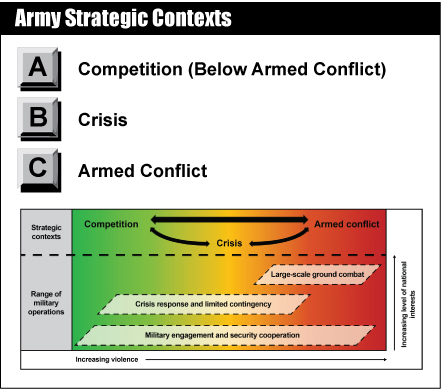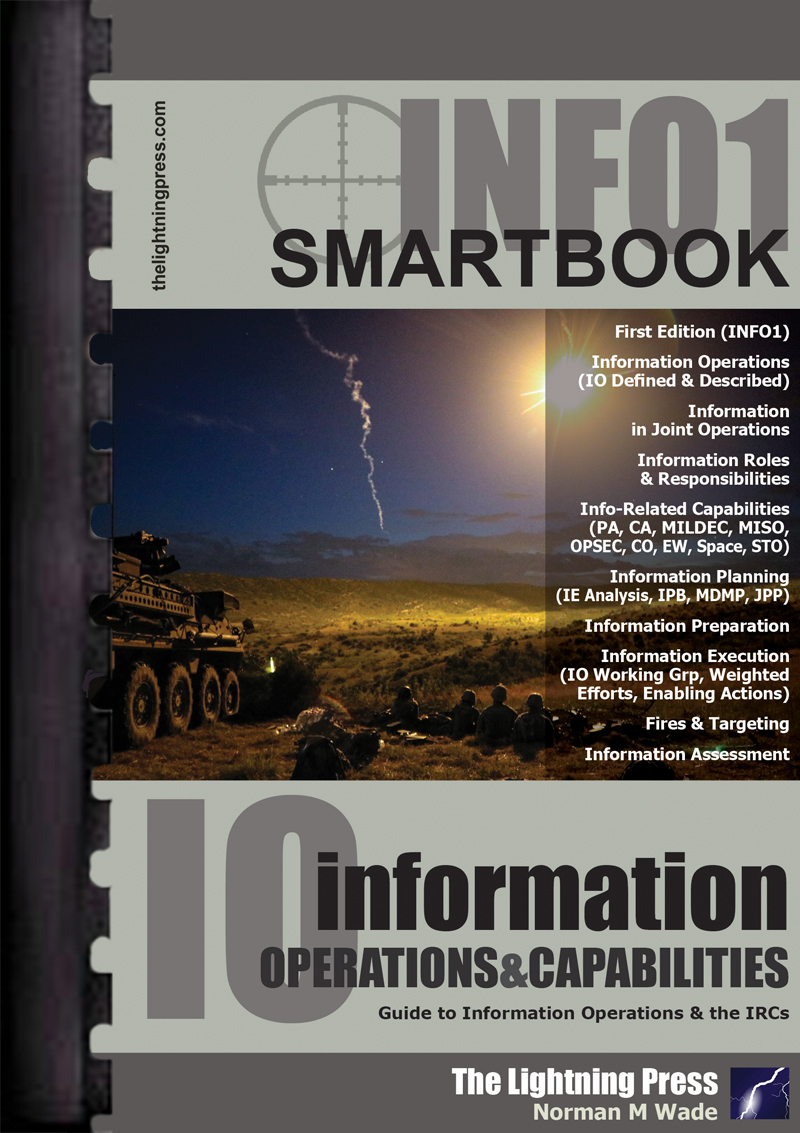Joint doctrine describes the strategic environment in terms of a competition continuum. Rather than a world either at peace or at war, the competition continuum describes three broad categories of strategic relationships—cooperation, competition below armed conflict, and armed conflict. Although combatant commands and theater armies campaign across the competition continuum, Army tactical formations typically conduct operations within a context dominated by one strategic relationship at a time. Therefore, Army doctrine describes the strategic situation through three strategic contexts in which Army forces conduct operations:

Multidomain operations are the combined arms employment of joint and Army capabilities to create and exploit relative advantages that achieve objectives, defeat enemy forces, and consolidate gains on behalf of joint force commanders. Employing Army and joint capabilities makes use of all available combat power from each domain to accomplish missions at least cost. Multidomain operations are the Army’s contribution to joint campaigns, spanning the competition continuum.
Consolidating Gains (Continuously)
Army commanders must exploit successful operations by continuously consolidating gains during competition, crisis, and armed conflict. Consolidate gains are activities to make enduring any initial operational success and to set the conditions for a sustainable security environment, allowing for a transition of control to other legitimate authorities (ADP 3-0). Consolidation of gains is an integral and continuous part of competition, and it is necessary for achieving success across the range of military operations. Successful consolidation of gains requires a realistic and pragmatic assessment of strategic conditions, ally and partner legitimacy, friendly and adversary relative advantages, and the viability of a sustainable political outcome. Operations to inform and influence foreign audiences also play a key role in achieving lasting outcomes.
During competition, Army forces may consolidate gains from previous conflicts for many years as JFCs seek to maintain relative advantages against a specific adversary and sustain enduring political outcomes. U.S. forces in Europe, Japan, the Republic of Korea, and the Middle East remained in place for decades to consolidate gains made in earlier conflicts. Army forces also consolidate gains by continuously developing multinational interoperability and readiness for large-scale combat operations.
During armed conflict, Army forces deliberately plan to consolidate gains throughout an operation as part of defeating the enemy in detail to accomplish overall policy and strategic objectives. Early and effective consolidation activities are a form of exploitation performed while other operations are ongoing, and they enable the achievement of lasting favorable outcomes in the shortest time span. Tactical units consolidating on an objective can be the first step in consolidating gains. In some instances, Army forces will be the lead for integrating forces and synchronizing activities to consolidate gains. In other situations, Army forces will be in support of allies and partners. Army forces may consolidate gains for a sustained period over large land areas. Military governments in occupied territories stabilize civilian populations. Military authorities may temporarily govern areas until populations are stable enough for transition to legitimate civilian authorities. This transition of control to civil authorities reduces demands on combat power.
While Army forces must continuously consolidate gains throughout an operation, consolidating gains becomes the overall focus of Army forces when large-scale combat operations have concluded. During competition, Army forces may consolidate gains from previous conflicts for many years as JFCs seek to maintain relative advantages against a specific adversary. During crisis, Army forces seek to consolidate whatever gains are made relative to a specific adversary so that the crisis does not occur again.
 This article is an extract from "AODS7: The Army Operations & Doctrine SMARTbook, 7th Ed. (Multidomain Operations)" by The Lightning Press. Download a free PDF sample and learn more at: AODS7: The Army Operations & Doctrine SMARTbook, 7th Ed. (Multidomain Operations).
This article is an extract from "AODS7: The Army Operations & Doctrine SMARTbook, 7th Ed. (Multidomain Operations)" by The Lightning Press. Download a free PDF sample and learn more at: AODS7: The Army Operations & Doctrine SMARTbook, 7th Ed. (Multidomain Operations).
Browse additional military doctrine articles in our SMARTnews Blog & Resource Center.
About The Lightning Press SMARTbooks. Recognized as a “whole of government” doctrinal reference standard by military, national security and government professionals around the world, SMARTbooks comprise a comprehensive professional library. SMARTbooks can be used as quick reference guides during operations, as study guides at education and professional development courses, and as lesson plans and checklists in support of training. Browse our collection of Military Reference SMARTbooks to learn more.













































